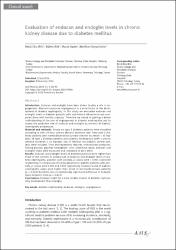| dc.contributor.author | Ekiz Bilir, Betül | |
| dc.contributor.author | Bilir, Bülent | |
| dc.contributor.author | Aydın, Murat | |
| dc.contributor.author | Soysal Atile, Neslihan | |
| dc.date.accessioned | 2022-05-11T14:14:04Z | |
| dc.date.available | 2022-05-11T14:14:04Z | |
| dc.date.issued | 2019 | |
| dc.identifier.issn | 1734-1922 | |
| dc.identifier.issn | 1896-9151 | |
| dc.identifier.uri | https://doi.org/10.5114/aoms.2018.79488 | |
| dc.identifier.uri | https://hdl.handle.net/20.500.11776/5767 | |
| dc.description.abstract | Introduction: Endocan and endoglin have been shown to play a role in angiogenesis. Aberrant excessive angiogenesis is a main factor in the development of diabetic nephropathy. In this study we evaluated endocan and endoglin levels in diabetes patients with and without albuminuria and compared them with healthy subjects. Therefore we aimed at gaining a better understanding of the role of angiogenesis in diabetic nephropathy and to assess the predictive role of endocan and endoglin as markers of diabetic nephropathy progression. Material and methods: Ninety-six type 2 diabetes patients were classified according to their 24-hour urinary albumin excretion rate. Forty type 2 diabetes patients with normoalbuminuria (urinary albumin excretion < 30 mg/day), 56 type 2 diabetes patients with diabetic nephropathy (with a urinary albumin excretion >= 30 mg/day) and 35 healthy non-diabetic control subjects were included. Their anthropometric features, arterial blood pressures, fasting glucose, glycated hemoglobin, urea, creatinine, lipids, endocan and endoglin levels were measured and compared to each other. Results: Endocan and endoglin levels of diabetics patients were higher than those of the controls. In comparison of endocan and endoglin levels of diabetic nephropathy patients with controls, p-values were < 0.001 and 0.002 respectively. In comparison of normoalbuminuric diabetic patients with controls, p-values were 0.001 and 0.017 respectively. Endocan levels of diabetic nephropathy cases were higher than those of normoalbuminuric patients (p = 0.011) but there was no statistically significant difference in endoglin levels between them (p = 0.822). Conclusions: Endocan might be a more reliable marker of diabetic nephropathy development than endoglin. | en_US |
| dc.language.iso | eng | en_US |
| dc.publisher | Termedia Publishing House Ltd | en_US |
| dc.identifier.doi | 10.5114/aoms.2018.79488 | |
| dc.rights | info:eu-repo/semantics/openAccess | en_US |
| dc.subject | diabetic nephropathy | en_US |
| dc.subject | endocan | en_US |
| dc.subject | endoglin | en_US |
| dc.subject | angiogenesis | en_US |
| dc.subject | Marker | en_US |
| dc.subject | Angiogenesis | en_US |
| dc.subject | Plasma | en_US |
| dc.subject | Esm-1 | en_US |
| dc.title | Evaluation of endocan and endoglin levels in chronic kidney disease due to diabetes mellitus | en_US |
| dc.type | article | en_US |
| dc.relation.ispartof | Archives of Medical Science | en_US |
| dc.department | Fakülteler, Tıp Fakültesi, Dahili Tıp Bilimleri Bölümü, İç Hastalıkları Ana Bilim Dalı | en_US |
| dc.department | Fakülteler, Tıp Fakültesi, Temel Tıp Bilimleri Bölümü, Tıbbi Biyokimya Ana Bilim Dalı | en_US |
| dc.identifier.volume | 15 | en_US |
| dc.identifier.issue | 1 | en_US |
| dc.identifier.startpage | 86 | en_US |
| dc.identifier.endpage | 91 | en_US |
| dc.institutionauthor | Bilir, Bülent | |
| dc.institutionauthor | Aydın, Murat | |
| dc.relation.publicationcategory | Makale - Uluslararası Hakemli Dergi - Kurum Öğretim Elemanı | en_US |
| dc.authorscopusid | 57200105523 | |
| dc.authorscopusid | 57200105522 | |
| dc.authorscopusid | 7102765266 | |
| dc.authorscopusid | 55556342300 | |
| dc.authorwosid | Bilir, Bülent/AAK-5656-2021 | |
| dc.identifier.wos | WOS:000455428200009 | en_US |
| dc.identifier.scopus | 2-s2.0-85060231175 | en_US |
| dc.identifier.pmid | 30697257 | en_US |



















